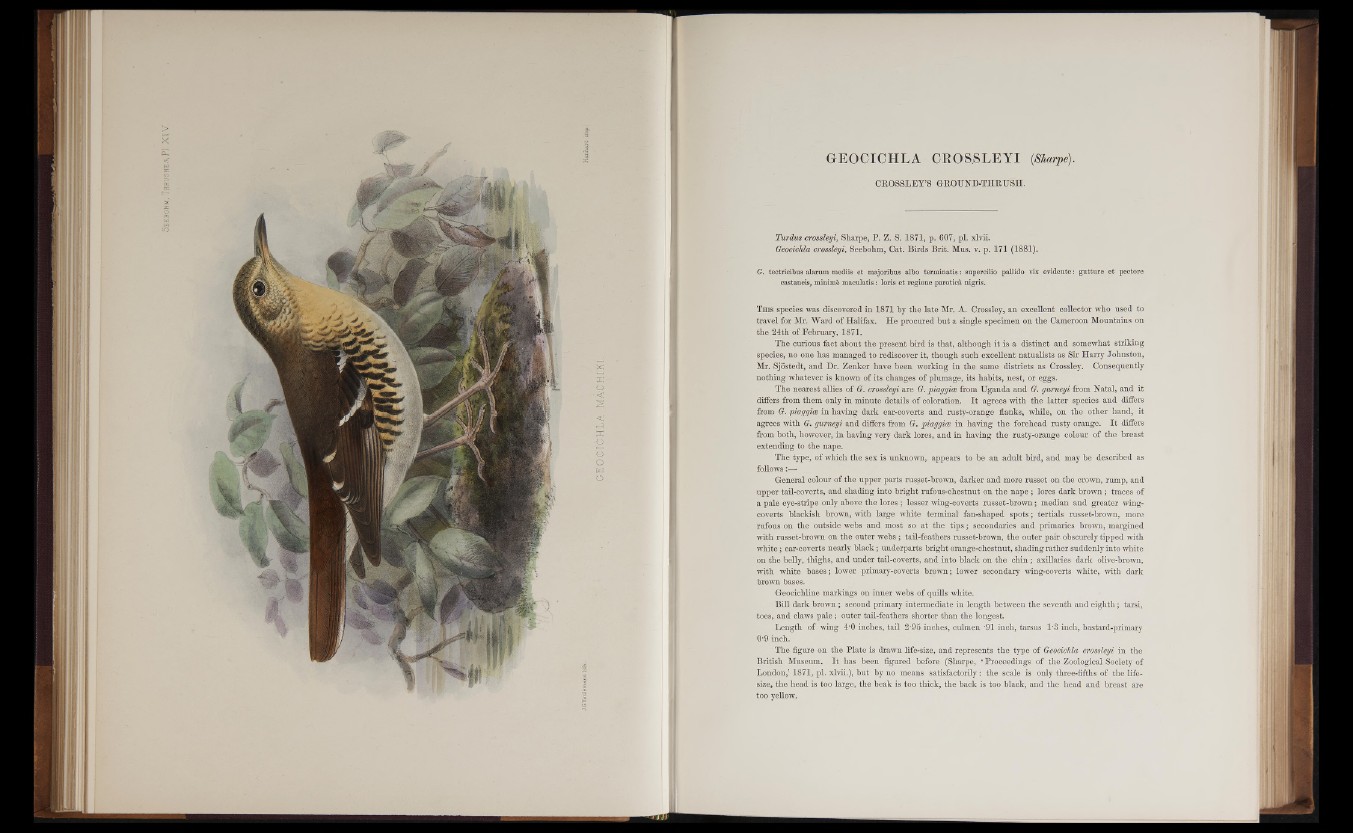
G E O e i 'C H - L A : MAC §
CfiOSSLBY’S GBOUND-THRUSH.
Turdus crossleyi, Sharpe, P. Z. S. 1871, p. 607, pi. xlvii.
Geocichla crossleyi, Seebohm, Cat. Birds Brit. Mus. v. p. 171 (1881).
G. tectricibus alarum mediis et majoribus albo terminatis: supercilio pallido vix evideute: gutture et pectore
castaneis, minimb maculatis: loris et regione parotic^ nigris.
T his species was discovered in. 1871 by the late Mr. A. Crossley, an excellent collector who used to
travel for Mr. Ward of Halifax. He procured but a single specimen on the Cameroon Mountains on
the 24th of February, 1871.
The curious fact about the present bird is that, although it is a distinct and somewhat striking
species, no one has managed to rediscover it, though such excellent natualists as Sir Harry Johnston,
Mr. Sjostedt, and Dr. Zenker have been working in the same districts as Crossley. Consequently
nothing whatever is known of its changes of plumage, its habits, nest, or eggs.
The nearest allies of G. crossleyi are G. piaggice from Uganda and G. gurneyi from Natal, and it
differs from them only in minute details of coloration. I t agrees with the latter species and differs
from G. gyiaggice in having dark ear-coverts and rusty-orange flanks, while, on the other hand, it
agrees with G. gumeyi and differs from G. 'piaggios in having the forehead rusty orange. It differs
from both, however, in having very dark lores, and in having the rusty-orange colour of the breast
extending to the nape.
The type, of which the sex is unknown, appears to be an adult bird, and may be described as
follows:—
General colour of the upper parts ruspet-brown, darker and more russet on the crown, rump, and
upper tail-coverts, and shading into bright rufous-chestnut on the nape; lores dark brown; traces of
a pale eye-stripe only above the lores ; lesser wing-coverts russet-brown; median and greater wing-
coverts blackish brown, with large white terminal fan-shaped spots; tertials russet-brown, more
rufous on the outside webs and most so at the tip s; secondaries and primaries brown, margined
with russet-brown on the outer webs ; tail-feathers russet-brown, the outer pair obscurely tipped with
white; ear-coverts nearly black; underparts bright orange-chestnut, shading rather suddenly into white
on the belly, thighs, and under tail-coverts, and into black on the chin; axillari.es dark olive-brown,
with white bases; lower primary-coverts brown; lower secondary wing-coverts white, with dark
brown bases.
Geocichline markings on inner webs of quills white.
Bill dark brown; second primary intermediate in length between the seventh and eighth; tarsi,
toes, and claws pale; outer tail-feathers shorter than the longest.
Length of wing 4*0 inches, tail 2*95 inches, culmen *91 inch, tarsus 1*3 inch, bastard-primary
0*9 inch.
The figure on the Plate is drawn life-size, and represents the type of Geocichla crossleyi in the
British Museum. It has been figured before (Sharpe, ‘ Proceedings of the Zoological Society of
London,’ 1871, pi. xlvii.), but by no means satisfactorily: the scale is only three-fifths of the life-
size, the head is too large, the beak is too thick, the hack is too black, and the head and breast are
too yellow.